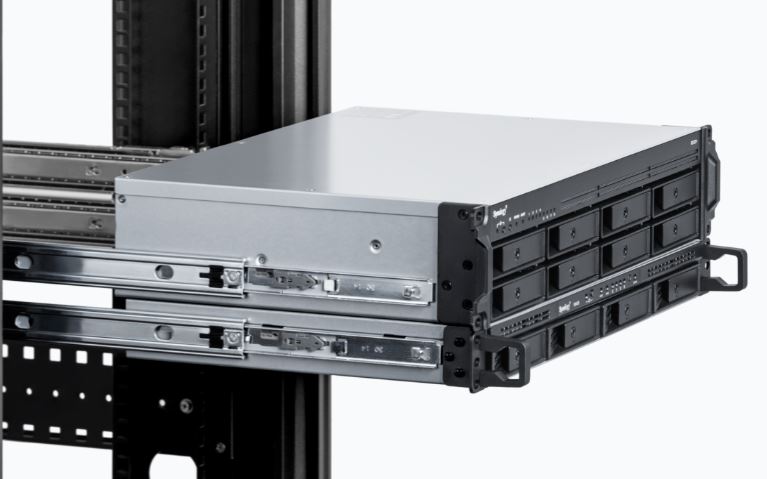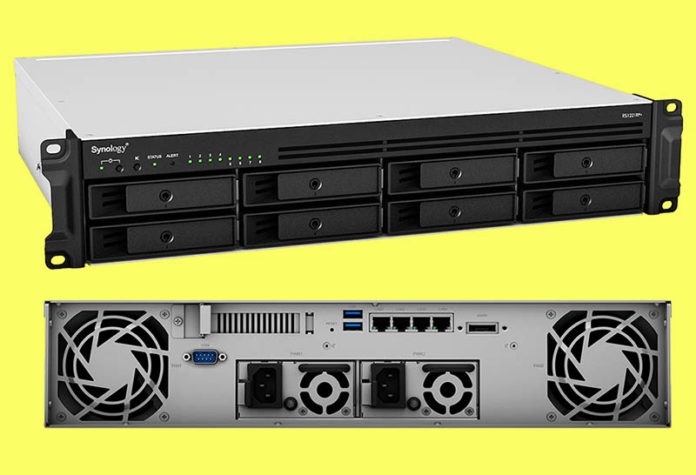The new Synology RackStation RS1221+ and RS1221RP+ rackmount NAS units have an intriguing spec. Specifically, they are trading the Intel Atom C2538 of their predecessor, the Synology RS1219+ for the AMD Ryzen V1500B. That means in one generation Synology has moved from a 2013 era Intel Atom processor to a 2018 era AMD Zen (1) based solution.
Synology RackStation RS1221+ and RS1221RP+
The NAS units are both 2U 8-bay units. One can find servers and NAS units that are 2U 12-bay but those tend to be much deeper units due to space constraints in a chassis.

Inside the system, the AMD Ryzen V1500B is a 4-core, 8-thread processor that runs at 2.2GHz. This change not only updates to a 5-year newer embedded processor but also changes the quad-core design from a legacy Atom design to a newer “big core” design that we find in mainstream server processors. There are some practical system-level changes as well since the Atom C2538 was a PCIe Gen2 part while the V1500B is a PCIe Gen3 part. PCIe Gen4 will be the focus in 2021, but the embedded segment tends to be a bit behind PCIe transitions.
The systems have 4GB of ECC SODIMM memory standard and one can upgrade to 2x16GB for 32GB total. Part of the Synology ecosystem’s appeal is that one can use the NAS units for more than just storage but also run applications and VMs on the units. 4GB in NAS units of this class feels a bit low in 2021 so perhaps Synology is just keeping base prices low with the expectation that customers will upgrade to 16GB or 32GB.
For rear I/O we get an eSATA port, a COM port, two USB 3.0 ports (another benefit of the newer Ryzen chip), and four 1GbE ports. This is one area where we wish Synology would have used an AMD EPYC 3000 series part such as the EPYC 3151 since that would have given the platform 10GbE MACs directly from the SoC. 1GbE in 2021 is still relevant, but we are seeing a major shift to 10GbE/ 2.5GbE as the Intel i225, Marvell, and Realtek 2.5GbE solutions hit the market. A good example of this is that the dual-NAS QNAP GM-1002 we just reviewed had both 2.5GbE and 10GbE standard on both NAS nodes in the system.

Synology has a single PCIe slot. This is a PCIe Gen3 x4 electrical slot in an x8 physical slot. One can add cache SSDs or 10GbE adapters but this naturally limits what can be added to the system.
We normally would feature each of these separately, however, the main difference between the two models is that the RS1221+ is a single fixed PSU model, while the RS1221RP+ is a dual power supply model. At first, we were wondering what would cause a $400 delta ($1299 v $1699) in price moving to redundant PSUs, especially at relatively low wattage levels, and it seems like more is going on here than just simply adding a second PSU.

In many servers and storage solutions that we review, a single PSU version of a machine simply does not have the second PSU added. In the Synology ecosystem, there is a much larger impact. While this may seem like a relatively small change, it actually increases the depth of the unit by about 1/3rd from 306.6mm (just under 12.1″) to 407.5mm (just under 16.1″) based on the online specs but 298mm and 399mm if we look at the datasheet. We are not sure why these two numbers do not match. We appreciate the shorter depth chassis. At the same time, it will make the decision harder for many of our readers since if one wants to add a B feed via a battery backup or a second power provider later, that is not possible. Having redundant power also makes swapping PDUs easier in racks.
Final Words
Both the Synology RackStation RS1221+ and RS1221RP+ are clear steps forward. Many of our readers will end up adding some combination of more memory, 10GbE, and/or NVMe storage so we see this more as a base price before options. There are other options that our readers will want. Since these are short-depth units, they seem to be designed for 2-post rack installations. As a result, rail kits are optional accessories.

We wish Synology used the AMD EPYC 3000 series here, instead of the Ryzen series. Cost may have been the major driver, but the EPYC 3000 series is designed more for embedded servers and storage. While the AMD 10GbE NICs are not the highest-end solutions out there (no SR-IOV support for example) it would have been a lower-cost way to add more 10GbE networking and also allow more expansion capability.
Synology has a loyal following, and this is clearly a big upgrade over the previous generation. Frankly, the average Synology buyer probably cares more about the internal specs than the form factor and that it is made by Synology. We just cover the overall market closely which is why we focus not just on what is, but what can be.





It’s crazy to see how much analysis goes into these STH articles. A STH “news” post has more depth than half of the reviews on Synology products. I hope you’re having a great 2021
I would love to buy the case for an ITX build at 306.6mm for the non-redundant PSU version it would be brilliant for home use to clean up the server/network pile into a small rack.
The V1500B has two built in 10GbE controllers, so the absence of 10GbE on this NAS is just the typical obtuse behavior of Synology
Same limited network as with the 1621+, there is no excuse for not providing a pair of 2.5GbE ports – except that people are not forced to buy their overpriced 10GbE NIC.
I’d be very happy with just a SFP+ interface built in. :-(
It’s 2021. No 10G and not even 2.5? What the actual…
Unless I’m missing something it’d be like $50-60 to upgrade to 8GB, two SFP+ cages and PHYs, let people use rj45 converters do 2.5-10 and upgrade some of those 1G’s to realtek 2.5G’s.
EPYC 3000s lets them do bigger everything.
I’m always in shock with how Synology gets away with this kind of stuff. That TrueNAS Mini X+ is a way better option.
Synology has the lowest speced parts with highest cost of the prosumer market. A non-server part and a non 10G port in 2021 for a rack mount unit, just to increase the already insane margins is laughable.
This iteration could have been so great, I was actually really looking forward to it. But the flaws keep me from upgrading to this system.
It’s basically a DS1821+ in rack form, but you don’t get a second expansion port like the DS1821+ – limiting you to only a 4 bay expansion and also no NVMe. What you do get on the other hand is a higher price tag. So paying (much) more for less…
Very disappointing.
The specs are underwhelming.
Really disappointed. So, seriously, the only people using these are in hard core labs or enterprise.
You basically have to choose between SSD NVMe Cache and Duel/Quad NIC’s.. The dual purpose PCI-E card is 10G-T only (no SFP+) with only 1 port. Sure you get NVMe cache with it but in a SAN setup, or VM setup, thats not enough. This seems like a half hearted attempt.. at best. Really need Dual SFP+ or more and ability to do NVMe cache.
Example: If you’re using this as production SAN, for example, you’ll NEED BOTH SSD Cache AND dual or quad 10G NIC’s.. The only way to get dual 10G AND SSD Cache is to sacrifice some drive bays.. Sloppy. :/
Especially when nearly every unit they are releasing now, including the new DS1621+ and the up coming DS1821+ has built in NVMe cache slot.. But, not the Rack version? Someone, explain this to me? Seems Lazy was on the menu with this model refresh.
A bit of catch-up to QNAP on the AMD side of things. I’m waiting for them to release an AMD version of the UC3200 platform.
Is this still working as of 2020? Sorry for the revival.